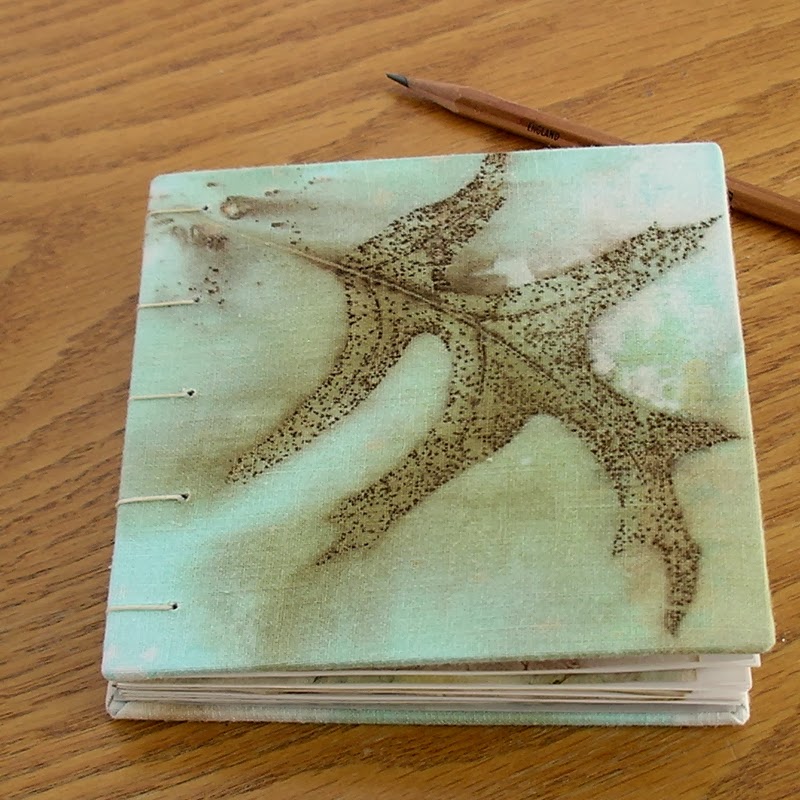I love scraps. The smallest piece can make my heart sing. I love to go through my piles, looking at what is left over from other projects. What I have come to learn is that working with the scraps is what makes me happiest. Making a whole out of disparate parts. So the last two snow days allowed me time to do so. Indigos and rust prints made on cast off linens and cottons come together with old paper and cardstock; cuts from watercolor papers used to make contact prints become book covers; small pieces of paper from larger book making adventures become the perfect size for the pages of souvenir books of summertime leaf printing. Small pieces of vintage threads become the ties that bind it all together.
And after being inside for way too long, I went out and shoveled snow to melt for my next dye experiments with red cabbage.
Wednesday, January 29, 2014
Sunday, January 19, 2014
CARROT TOP EXPERIMENTS
I spent the week working with carrot tops saved from our summer garden. We keep our carrots in the ground until we need them or the ground freezes. With the mild autumn we had, we still had some in the ground until the first week of December. Not bad for Colorado! Each time we brought some in from the garden I stored the tops in the freezer. Since doing this I learned that it would be better to store them dry. Will have to try that next year.
Top left scraps photo are silk dyed in Wheeler spring water which has the highest amount of copper. Middle two fabrics (silk left, vintage cotton right) were dyed in Seven Minute Spring water which has an even distribution of all minerals. Love the color of the vintage cotton(premordant with alum). Right three scraps are two different types of silk and a vintage cotton dyed in tap water. The middle piece of silk was wrapped around a copper pipe. Not very visible in the photo but there is a difference in color between it and the left silk without the copper pipe.
Next row is silk and vintage cotton dyed in Iron spring water named because of its high content of iron. Again not very visible in the photo, but a more muted, grayed green.
So I'm out of carrot tops for now. There are still two more springs I want to test with carrot tops but that will have to wait till next summer's crop.
This week I'll be in the library researching Dr. William Bell, founder of Manitou Spring. I know that he and his wife had a garden, and I would like to find out what they planted and if any were dye plants.
*Manitou Springs Mineral Foundation
Sunday, January 12, 2014
RECORD KEEPING
In 2008 I learned to make a flag book. It was fun to learn to make this structure but I came away from the workshop thinking I would probably never make this type of book again. It sat on a corner shelf in my basement until this past summer when I was trying to come up with a way to keep track of my eco prints on paper. I wanted a way to display my prints by season so that I would be able to see differences in pigments using the same plants but at different times of the year.
So I used the same flag book structure to make this book with prints made during June, July and August. A variety of leaves were used including Silver Maple, Aspen, Cottonwood, Juniper, Geranium, Gambel Oak, Crabapple, Chokecherry and Serviceberry as well as petals from Coreopsis, Marigold and Iris plants. The cover was made using only iris and marigold petals.
Last week I finished another flag book recording prints made during September, October and November. Leaves from the same plants were used but were showing their autumn pigments. I also included berries from plants available during those three months (Chokecherry and Woodbine).
Cover fabric is vintage cotton mordanted with alum and printed with Woodbine berries, Gambel Oak, Norway Maple and Rose leaves and a few Coropsis petals.
I am very happy with this method of recording my prints and am presently working on my book for December, January and February.
Last week I finished another flag book recording prints made during September, October and November. Leaves from the same plants were used but were showing their autumn pigments. I also included berries from plants available during those three months (Chokecherry and Woodbine).
Cover fabric is vintage cotton mordanted with alum and printed with Woodbine berries, Gambel Oak, Norway Maple and Rose leaves and a few Coropsis petals.
Monday, January 6, 2014
POETRY TO BEGIN WITH
WHAT WE NEED IS HERE
Geese appear high over us,
pass, and the sky closes. Abandon,
as in love or sleep, holds
them to their way, clear
in the ancient faith; what we need
is here. And we pray,
not for new earth or heaven, but to be
quiet in heart, and in eye,
clear. What we need is here.
--Wendell Berry
Geese appear high over us,
pass, and the sky closes. Abandon,
as in love or sleep, holds
them to their way, clear
in the ancient faith; what we need
is here. And we pray,
not for new earth or heaven, but to be
quiet in heart, and in eye,
clear. What we need is here.
--Wendell Berry
Subscribe to:
Comments (Atom)















